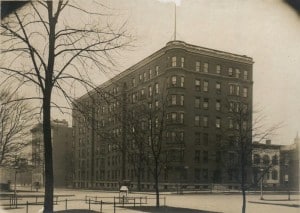In 1893, Harper and Brothers published Lew Wallace’s third novel, The Prince of India; or, Why Constantinople Fell. They paid Lew a $100,000 advance for the novel; he apparently decided it was time to invest in real estate. As a result, he and his son Henry began planning a luxury apartment building in Indianapolis.
The Blacherne

Henry engaged architect John G. Thurtle to design a “fireproof” building made of vitrified brick and limestone. They purchased a lot on the northwest corner of Meridian and Vermont Streets for the apartments. Thurtle designed a seven-story, Romanesque Revival-style building. The lower six floors boasted eight-room apartments, while the top floor apartments were three or four rooms. H.R. Saunders created limestone friezes with snakes, lions, and human faces.
Both men later helped with the creation of Lew’s private Study. According to legend, Lew drew the Study design himself. He then presented the design to Thurtle, who proclaimed no changes necessary. H.R. Saunders created the four faces that decorate the limestone frieze on the outside of the Study.
The Blacherne boasted an elevator that serviced all seven floors of the high rise. It featured elaborate Roman arches, prominent bow windows, solid brick construction, chandeliers, and ornate stone embellishments.
By the early 1960s, the building was beginning to show its age. The city purchased it in 1966, but plans for renovation with public funds never materialized. It returned to the private sector in 1972, but continued to go downhill. From January 1 to May 31, 1997, police responded to calls at the Blacherne 1,400 times—almost 3 runs per day.
Ultimately conditions became so bad that all federal funding for public housing were cut off and the remaining tenants were evicted. The future looked bleak until a group of investors purchased the property and renovated it. The beautifully renovated apartment building reopened with a number of floor plans available for rent.
The Prince of India
On April 19, 1881, President James A. Garfield wrote, “Awoke at half-past five, and finished ‘Ben Hur’ in bed. It is a book of great power. Wallace surprises me with his delicacy and penetration, as well as his breadth of culture. I think Constantinople would give him opportunities for yet greater success, and I will try to give him that Mission.”
and I will try to give him that Mission."~Pres. James A. Garfield, Apr. 19, 1881. Here the President speaks of "Ben Hur" author Lew Wallace (pictured). Garfield did appoint Wallace as U.S. Minister to the Ottoman Empire. Follow @wallacestudy to learn more about Wallace. 2/2
— J. A. Garfield NHS (@GarfieldNPS) April 19, 2019
While Lew was in Constantinople, he began researching the novel that would become The Prince of India. The book, set in in the 1400s, centers on a character who calls himself the Prince of India. The man is actually a Jewish man cursed with immortality because he mocked Jesus on the way to the cross.
The Prince goes to Constantinople to propose one world religion. When Emperor Constantine rejects this notion, the Prince betrays the city to Prince Mahommed (Mehmed II). Mahommed’s forces take Constantinople and he becomes the Sultan of the Ottoman Empire.
The Blachernae Palace
The Blachernae Palace features heavily in The Prince of India. In this passage, Lew describes the the inner court:
They entered an extensive inner court, surrounded on three sides by a gallery resting on pillars. On the fourth side, a magnificent staircase ascended to a main landing, whence, parting right and left, it terminated in the gallery. Floor, stairs, balustrading, pillars, everything here was red marble flooded with light from a circular aperture in the roof open to the sky.
Blachernae was built in the 6th century and expanded several times over the centuries. In the 11th century, Emperor Alexios I Komnenos made the palace his permanent residence. The Palace of the Porphyrogenitus, or Tekfur Sarayi, was built in the 13th century as an annex to the Blachernae. By the time of the Ottoman conquest in 1453, that was likely the only portion of the palace in use. The Porphyrogenitus still stands and serves as a prime example of Byzantine architecture in Istanbul.